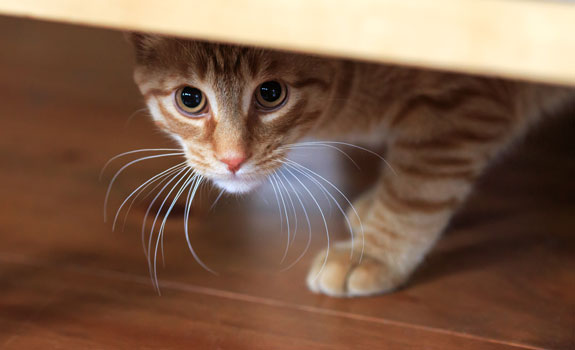Facts About Cat Whiskers

Whether you're a cat owner or not, maybe you've wondered at some point what the purpose of a cat's whiskers are. Many animals actually possess whiskers – they aren't unique to only cats – but cats tend to be most associated with them. If you've ever been curious as to why cats have them, what their purpose is, and some other fun facts, read on!
WHAT ARE WHISKERS?
In case your unfamiliar with whiskers, they are white-colored hairs that stick out on each side of your cat's nose and mouth area. They are significantly thicker than a strand of hair or fur. They also have roots that are three times deeper than the rest of an animal's fur. You might think of whiskers as being on either side of a cat's face, but did you know that cats actually have whiskers on other parts of their body as well? They have them on other parts of their face such as above their eyes and near their ears. They even have whiskers on their legs!
WHISKER ANATOMY
Whiskers are considered to be tactile hairs and are much more sensitive than any of the hair that we have as humans. Youi might compare their sensitivity to that of a human's fingertip. Because they are rooted so deep, they are connected to the muscular and nervous system. While the actual whiskers themselves don't feel anything, the muscles they are attached to do. Thus, whiskers are used to transmit sensory information about what objects and other elements are around them.
While it's hard to know how many total whiskers a cat has, we do know that cats are born with 24 whiskers near their mouth, 12 on each side of their face. While it's normal for cats to shed their whiskers since they grow back like hair, you want to be sure that they aren't rapidly losing them or dealing with breakage. This could potentially be a sign of a serious underlying issue.
WHAT IS THE PURPOSE OF CAT WHISKERS?
Believe it or not, whiskers actually have multiple purposes, each of them helping a cat to stay safe and aware of its surroundings.

The first purpose is to help cats feel what's around them. Just like we stated above, whiskers essentially are able to feel things like we do with our fingers. A cat's whiskers paired with their night vision help them to navigate easily in the dark and at night. They also help with a cat's close-up vision.
The second purpose of whiskers is that they aid with balance. You probably already know that cats are experts when it comes to balancing and maneuvering on small ledges and in tight spaces. This is in part because of their whiskers! Their whiskers grown symmetrically on their body, helping cats stay balanced through all of their movement.
Another purpose of whiskers is to help sense vibrations. With this, they can sense changes in the air or even if there is prey around the corner. Amazingly enough, whiskers are even able to use the vibrations to gather information about objects that are nearby. For indoor cats, this may be helpful in sensing where their food is location or where their favorite toy is hidden.
OTHER FUN FACTS ABOUT CAT WHISKERS
- Whiskers can display sign's of a cats emotions. When a cat is relaxed, its whiskers will likely reflect this by being limp. However, when a cat is stressed of feeling threatened, its whiskers will be stiffer and pulled back. You may also notice that when a cat is curious or investigating something, its whiskers will be in a more forward position.
- Whiskers can change color. Just like how human hair changes color as we age, a cat's whiskers will also change colors as it grows older, as well. They may get darker and turn gray or black as a cat ages.
- Cats can gauge how wide a space is with their whiskers. Because they have whiskers all over the exterior of their body, cats are able to use them to sense how tight a space is before entering to make sure they don't get stuck.
NEVER TRIM YOUR CATS WHISKERS!
A cat's whiskers are constantly at work sensing what's around them and if there's any kind of threat or danger. By trimming a cat's whiskers, you are taking away a vital part of how they sense the world, not to mention potentially causing them to struggle with balance issues. Even if you may think your cat's whiskers are too long, know that they're long for a reason. Don't throw off your pet's balance or ability to sense their surroundings by giving them a trim. Leave them be!
CONCLUSION
Hopefully this article has helped you learn a little bit more about your furry friend! Whiskers may not look like much, but they are an essential part of how a cat operates in their daily life, environment, and how they stay safe.
Previous article

Next article

Related posts
View all-

National K9 Veterans Day: Why and How to Celebrate
National K9 Veterans Day is celebrated every year on March 13th. This year its on Saturday March 13th, 2024. This day was established to recognize and celebrate the contributions that Military Working Dogs.
Read Article -

Puppy Training Tips
Training your pup from day one helps set a solid foundation for good behavior and a well-adjusted adult dog. Puppies thrive on structure, and a predictable routine makes learning easier.
Read Article -

Spring Cleaning Tips for Pet Parents
Say goodbye to the winter germs and hello to all the new spring smells! The beginning of spring is the perfect time to clean your house. For pet owners, this can mean more in-depth cleaning in areas other people don't have to worry about. We will give you some helpful tips and tricks so that cleaning up after your pet seems a little less daunting. Read Article



